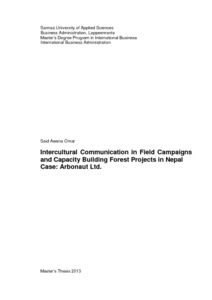Intercultural Communication in Field Campaigns and Capacity Building Forest Projects in Nepal, Case: Arbonaut Ltd.
Said, Awena (2013)
Said, Awena
Saimaan ammattikorkeakoulu
2013
All rights reserved
Julkaisun pysyvä osoite on
https://urn.fi/URN:NBN:fi:amk-201303052959
https://urn.fi/URN:NBN:fi:amk-201303052959
Tiivistelmä
Intercultural conflicts usually happen in organizations, particularly in international organizations, when people or teams from different cultural backgrounds are working together. The topic of this research was intercultural communication in field campaigns and capacity building forest projects in Nepal. It was intended to find out the sources of intercultural conflicts between an international team and a Nepalese team as well as between the international team and local Terai people during the LiDAR field campaign in Nepal. The possible ways, which will alleviate the conflicts, were also recommended.
The study consists of theory and empirical data. The cultural information of Finland and Nepal were theoretically collected through literature. The empirical data of Arbonaut Ltd’s culture was collected through a questionnaire whereas data of the intercultural conflicts, the main theme of this research, was collected through interview. The GLOBE nine cultural dimensions were used as a theory to collect data.
Based on the findings, intercultural conflicts happened in different cultural environments. Differences in time management, nepotism, lack of involvement of team members in decision making, interference of planned project decisions, less respect of status, less sharing of information and issues of authority were the sources of conflicts. The results will be useful to Arbonaut Ltd., particularly to the international team to know cultural differences between them and the Nepalese team and the sources of intercultural conflicts faced them during the project. This will help to reduce conflicts in next similar field campaigns. Also it will be helpful to other organizations that operate in similar environments.
The study consists of theory and empirical data. The cultural information of Finland and Nepal were theoretically collected through literature. The empirical data of Arbonaut Ltd’s culture was collected through a questionnaire whereas data of the intercultural conflicts, the main theme of this research, was collected through interview. The GLOBE nine cultural dimensions were used as a theory to collect data.
Based on the findings, intercultural conflicts happened in different cultural environments. Differences in time management, nepotism, lack of involvement of team members in decision making, interference of planned project decisions, less respect of status, less sharing of information and issues of authority were the sources of conflicts. The results will be useful to Arbonaut Ltd., particularly to the international team to know cultural differences between them and the Nepalese team and the sources of intercultural conflicts faced them during the project. This will help to reduce conflicts in next similar field campaigns. Also it will be helpful to other organizations that operate in similar environments.
